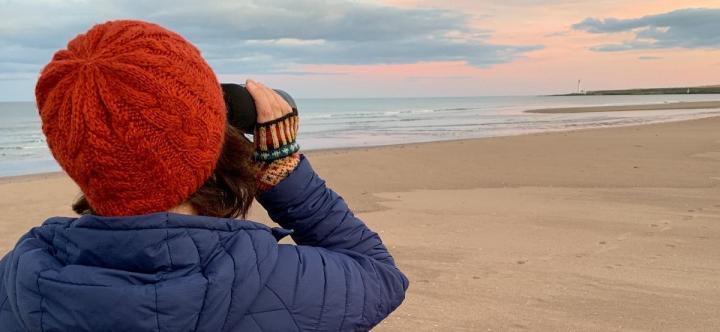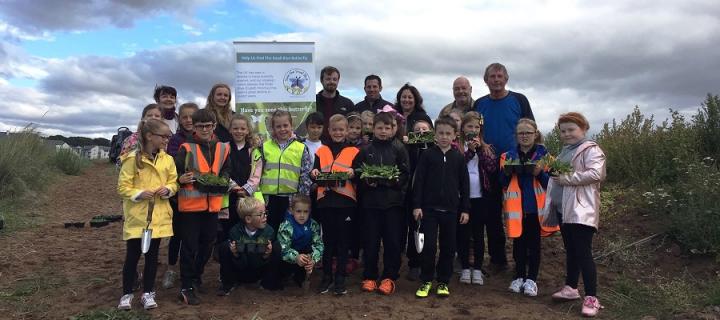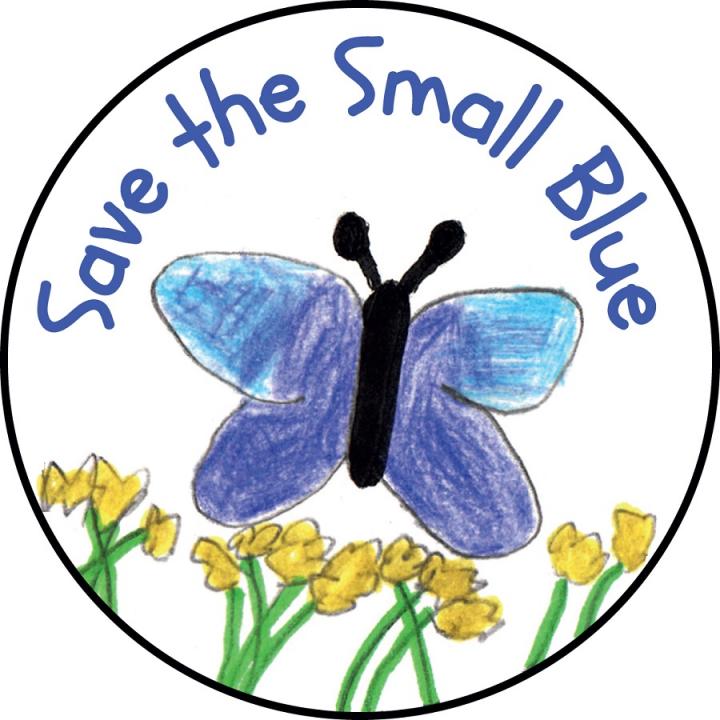Back from the Brink: Saving our Small Blue
MSc graduate Kelly Ann Dempsey's dissertation on the habitat of the rapidly declining Small Blue Butterfly helped inform the Tayside Biodiversity Partnership project with local landowners and community, aiding in the conservation of the species in North East Scotland.

Community
Coastal communities in Angus have enthusiastically worked together since 2012 to understand and halt the sharp decline of one of our most iconic coastal species – the Small blue butterfly. This engaging project, celebrated by the community, demonstrates how working together may provide a future to a species on the brink. The project, managed by the Tayside Biodiversity Partnership’s Small Blue Interest Group, is an example of collaborative, community-focused conservation.
During 2013/2014, the group focussed on distribution, land management practices and restoration potential, aided by Kelly Ann’s MSc project “Back from the Brink: Using a Local, Collaborative Approach to aid in the Rescue of a Vulnerable, Fragmented Cupido minimus Population in North East Scotland”. Kelly Ann is chair of the Tayside Local Biodiversity Partnerships’ Coastal and Marine Working Group and a member of the Small Blue Special Interest group who have the developed the project over the last 8 years.
The project’s first conservation aim was to establish the butterfly’s historic and current distribution along with its food-plant, kidney vetch. Some 160 survey records from over 30 years were consolidated using ArcMap GIS 9. This highlighted the variance in numbers of Small Blue over time. Kidney vetch had only been surveyed once (in 1994), but since 2013 it is surveyed annually. It is now abundant along much of the coast.
As the second objective was to generate awareness with landowners and communities, in 2013, 21 coastal landowners completed a questionnaire. An excellent return rate of 78% was achieved: almost 75% had neither seen nor had any knowledge of either species. Encouragingly, 79% responded ‘yes’ to considering managing land for wildlife so where grazing or development could be detrimental, guidance was offered to facilitate sympathetic practices.

Impact
A group of eight champions has grown to more than 38 individuals and organisations delivering Angus-wide Small blue conservation. Since 2013 more than 85 volunteers have trained to survey both species and to date 10 landowners are engaged in habitat management for Small blue and Kidney vetch.
Communities playing a crucial supporting role. Kidney vetch corridors have expanded because of community volunteering – growing on and planting kidney vetch plug plants grown from local provenance seeds. Since 2015 over 500 Kidney vetch plants have been planted at more than 10 sites by around 100 community volunteers. This has enhanced important Kidney vetch corridors, linking isolated meta-populations. Planting sites are monitored and information is shared on planting successes and challenges. Climate change continues to threaten butterfly populations and going forward, in addition to enhancing ecological connectivity, the project’s focus will move towards enhancing vegetation and shelter alongside Kidney vetch and increasing resilience through mitigation plans for at risk sites.

Award
In 2019 the Small Blue Interest Group submitted the project as a contender for the RSPB Nature of Scotland “Community Initiative Award and the Association of Local Government Ecologists “Local Authority Biodiversity Project Award”. The project one not one, but two awards in early December. The project group, Tayside Biodiversity partnership, Local Authority and most importantly the Angus community were thrilled and very proud.
Joys of working with local groups
During the lifetime of the project volunteer effort exceeds 100’s of person-hours and 50% of coastal landowners are engaged in practical restoration. Outreach has surpassed expectations. Angus is proud to have a local councillor and a school as “Small Blue Champions” working alongside dedicated Angus communities that want to secure the Small blue’s future. Angus communities have helped to make national “Small Blue Week” a success. Woodlands Primary School in Carnoustie, the first Angus School Species Champion launched the event in 2016. The project has brought together all age groups which has been very heartening to witness.
Angus Coastal Festival 2020 - Year of Coasts and Waters
Following the publication of the Tayside Local Biodiversity Action Plan 2016-26, the Tayside Biodiversity Partnership decided to hold the first ever Angus Coastal Festival in September 2018. The festival’s aim was to raise awareness of some of the iconic species and habitats of the Angus coast and provide an opportunity to engage with coastal communities and partners. The 2018 Angus Coastal Festival was enjoyed by more than 700 people, our Summary Report highlights its success. The event ran again in 2019 and planning is in progress for special 2020 events during 2020 - Year of Coasts and Waters.
Related Links
Tayside Biodiversity Partnership

